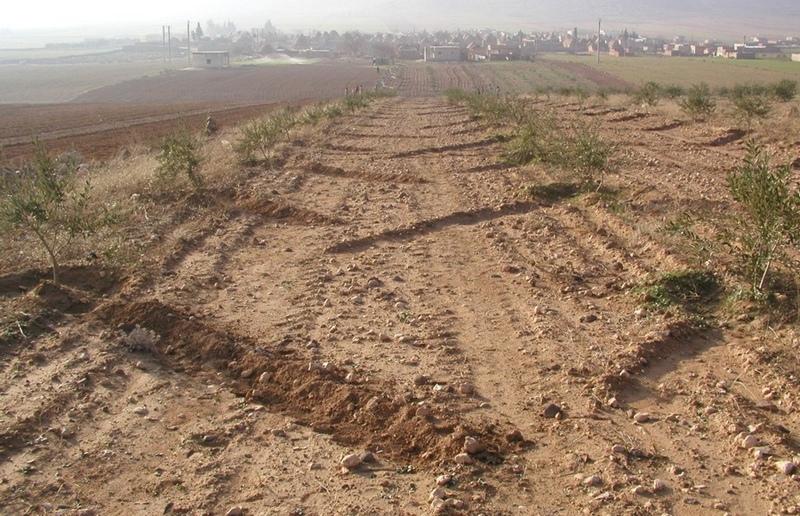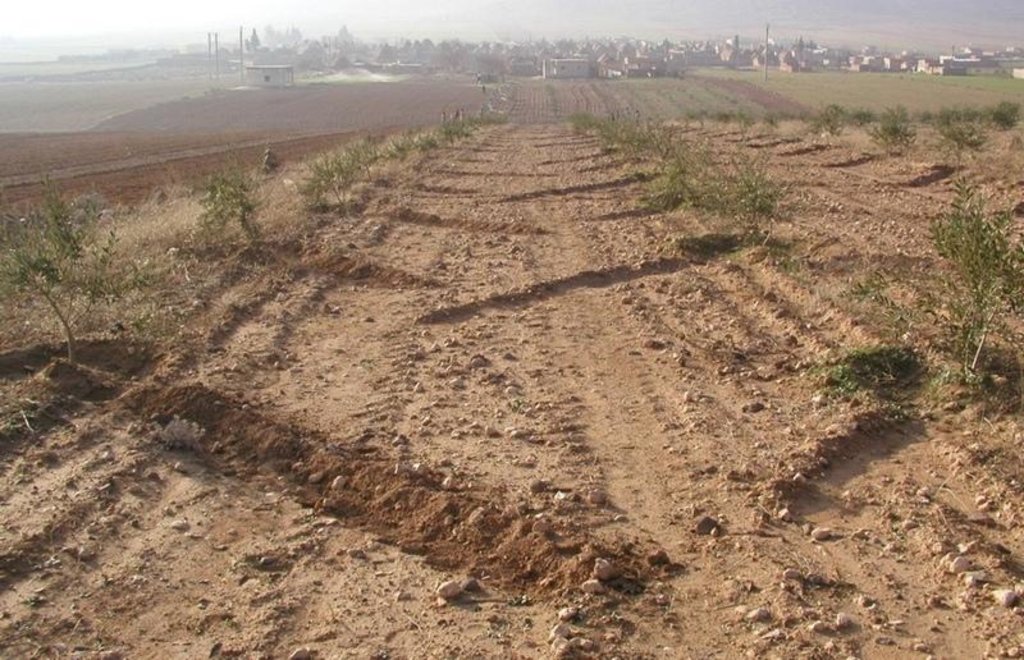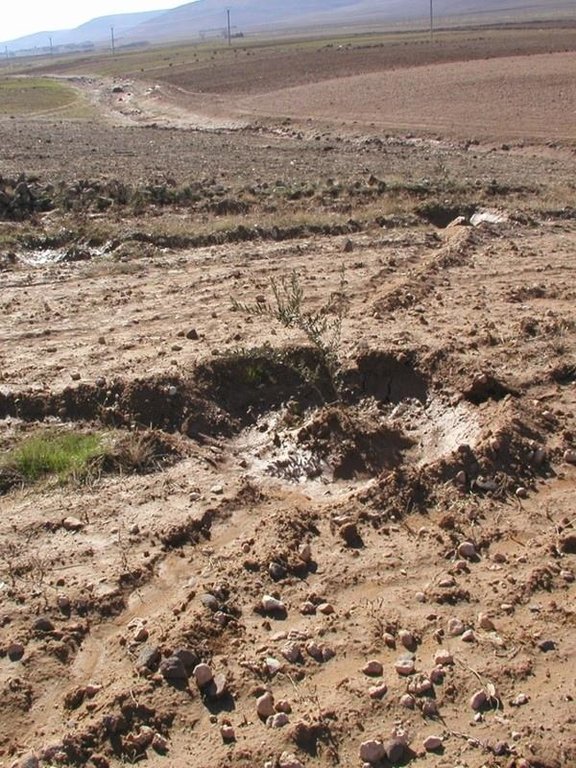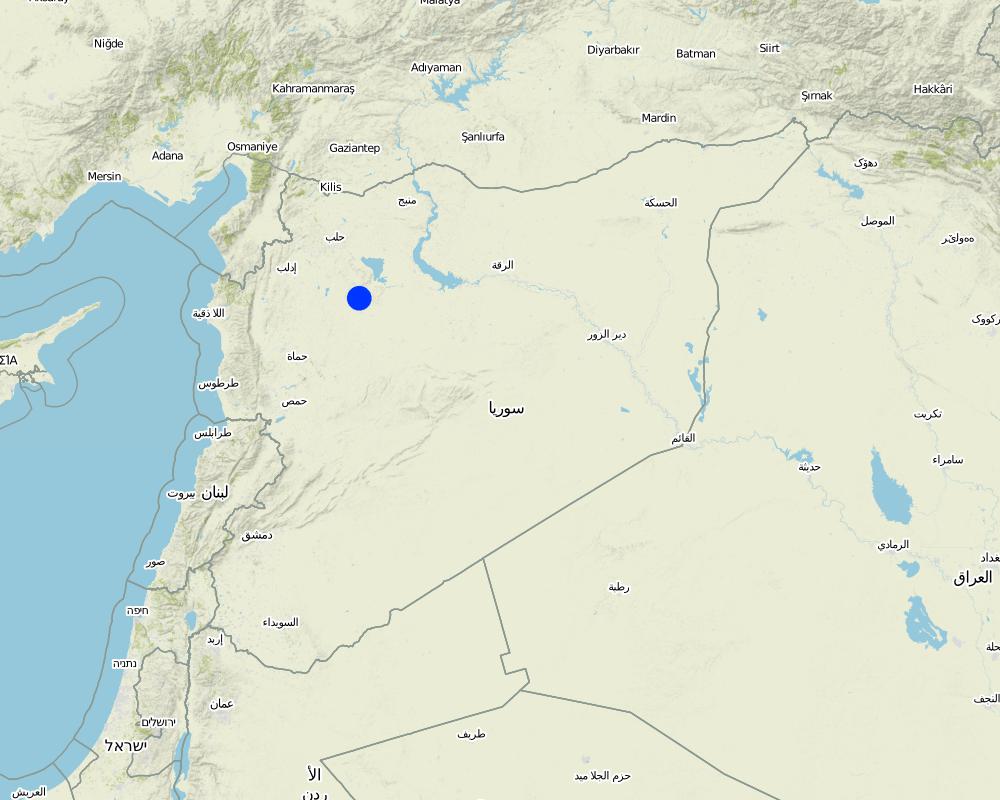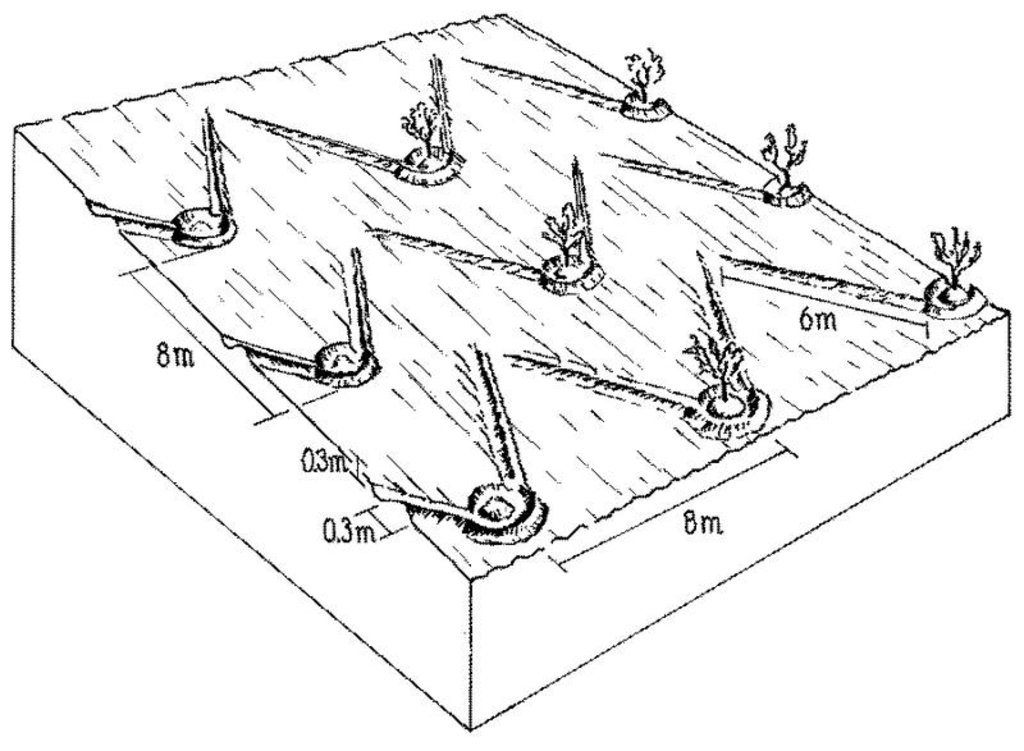Furrow-enhanced runoff harvesting for olives [ซีเรีย]
- ผู้สร้างสรรค์:
- การอัพเดท:
- ผู้รวบรวม: Francis Turkelboom
- ผู้เรียบเรียง: –
- ผู้ตรวจสอบ: Deborah Niggli, Alexandra Gavilano
technologies_1005 - ซีเรีย
ดูส่วนย่อย
ขยายทั้งหมด ย่อทั้งหมด1. ข้อมูลทั่วไป
1.2 รายละเอียดที่ติดต่อได้ของผู้รวบรวมและองค์กรที่เกี่ยวข้องในการประเมินและการจัดเตรียมทำเอกสารของเทคโนโลยี
ผู้เชี่ยวชาญ SLM:
Tubeileh Ashraf
ICARDA
ซีเรีย
ผู้เชี่ยวชาญ SLM:
La Rovere Roberto
ซีเรีย
ผู้เชี่ยวชาญ SLM:
Burggeman Adriana
ซีเรีย
ชื่อของโครงการซึ่งอำนวยความสะดวกในการทำเอกสารหรือการประเมินเทคโนโลยี (ถ้าเกี่ยวข้อง)
Book project: where the land is greener - Case Studies and Analysis of Soil and Water Conservation Initiatives Worldwide (where the land is greener)ชื่อของโครงการซึ่งอำนวยความสะดวกในการทำเอกสารหรือการประเมินเทคโนโลยี (ถ้าเกี่ยวข้อง)
Book project: Water Harvesting – Guidelines to Good Practice (Water Harvesting)ชื่อขององค์กรซึ่งอำนวยความสะดวกในการทำเอกสารหรือการประเมินเทคโนโลยี (ถ้าเกี่ยวข้อง)
International Center for Agricultural Research in the Dry Areas (ICARDA) - เลบานอน1.3 เงื่อนไขการใช้ข้อมูลที่ได้บันทึกผ่านทาง WOCAT
ผู้รวบรวมและวิทยากรหลักยอมรับเงื่อนไขเกี่ยวกับการใช้ข้อมูลที่ถูกบันทึกผ่านทาง WOCAT:
ใช่
1.4 การเปิดเผยเรื่องความยั่งยืนของเทคโนโลยีที่ได้อธิบายไว้
เทคโนโลยีที่ได้อธิบายไว้นี้เป็นปัญหาของความเสื่อมโทรมโทรมของที่ดินหรือไม่ จึงไม่ได้รับการยอมรับว่าเป็นเทคโนโลยีเพื่อการจัดการที่ดินอย่างยั่งยืน:
ไม่ใช่
1.5 Reference to Questionnaire(s) on SLM Approaches (documented using WOCAT)
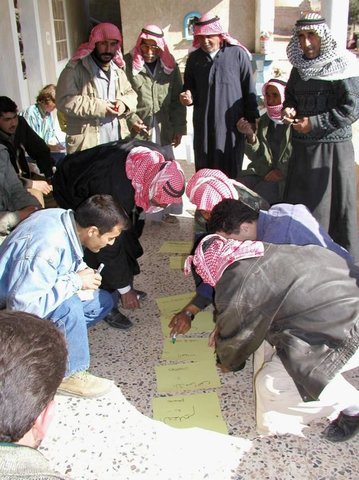
Participatory technology development [ซีเรีย]
Participatory technology development, through close researcher-farmer interaction, for sustainable land management of olive orchards in dry marginal areas.
- ผู้รวบรวม: Francis Turkelboom
2. การอธิบายลักษณะของเทคโนโลยี SLM
2.1 การอธิบายแบบสั้น ๆ ของเทคโนโลยี
คำจำกัดความของเทคโนโลยี:
Runoff harvesting through annually constructed V-shaped microcatchments, enhanced by downslope ploughing.
2.2 การอธิบายแบบละเอียดของเทคโนโลยี
คำอธิบาย:
The Khanasser Valley in north-west Syria is a marginal agricultural area, with annual rainfall of about 220 mm/year. Soils are shallow and poor in productivity. The footslopes of degraded hills are traditionally used for extensive grazing or barley cultivation. However to achieve self-sufficiency in olive oil production, several farmers have developed orchards in this area - which is generally considered too dry for olives.
Trees are spaced at 8 m apart, within and between rows. Traditionally, farmers prefer to till their orchards by tractor in order to keep them weed-free (weeds may attract sheep, lead to fires and compete for water with the olive trees). As this tillage operation is usually practised up and down the slope, the resulting furrows stimulate runoff and erosion. However, when this is combined with Vshaped and/or fish-bone shaped microcatchments around individual trees, the furrows created can be used to harvest runoff water for improved production.
The V-shape earthen bunds (reinforced with some stones) are constructed manually, by hoe, around each tree. The furrows then divert runoff systematically to the microcatchments where it concentrates in basins around the trees. Each tree is effectively served by a catchment area of 60 m2. The catchment: cultivated area ratio is thus approximately 60:1 (assuming the area exploited by the tree.
This technology saves irrigation water during the dry season, enhances soil moisture storage, and stimulates olive tree growth. Furthermore, fine particles of eroded soil are captured in the microcatchments. While these may be nutrientrich, they also tend to seal the surface. The bunds need to be rebuilt every year. If the structures are damaged after a heavy storm, they need to be repaired. Labour input for establishment and maintenance is low, the technology is easy and cheap to maintain, and there is enough local skill to sustain and expand the system. A supporting technology is to mulch the area around each tree with locally available stones (limestone and/or basalt) to reduce soil temperature during the summer, decrease surface evaporation and improve infiltration. The catchment areas between the trees are sometimes planted with low water-demanding winter annuals (lentils, vetch, barley, etc) especially when the trees are young. This helps to reduce surface erosion. Implementation of furrow-enhanced runoff water harvesting in olive orchards started in 2002, and adoption by farmers is growing gradually.
2.3 รูปภาพของเทคโนโลยี
2.5 ประเทศภูมิภาค หรือสถานที่ตั้งที่เทคโนโลยีได้นำไปใช้และได้รับการครอบคลุมโดยการประเมินนี้
ประเทศ:
ซีเรีย
ภูมิภาค/รัฐ/จังหวัด:
Aleppo, NW Syria
ข้อมูลจำเพาะเพิ่มเติมของสถานที่ตั้ง :
Khanasser Valley
แสดงความคิดเห็น:
Total area covered by the SLM Technology is 0.05 km2.
Map
×2.7 คำแนะนำของเทคโนโลยี
ให้ระบุว่าเทคโนโลยีถูกแนะนำเข้ามาอย่างไร:
- ทางโครงการหรือจากภายนอก
3. การจัดประเภทของเทคโนโลยี SLM
3.1 วัตถุประสงค์หลักของเทคโนโลยี
- ปรับปรุงการผลิตให้ดีขึ้น
- ลด ป้องกัน ฟื้นฟู การเสื่อมโทรมของที่ดิน
- สร้างผลกระทบทางด้านเศรษฐกิจที่เป็นประโยชน์
3.2 ประเภทของการใช้ที่ดินในปัจจุบันที่ได้นำเทคโนโลยีไปใช้
Land use mixed within the same land unit:
ใช่
Specify mixed land use (crops/ grazing/ trees):
- ปศุสัตว์ร่วมกับการทำป่าไม้ (Silvo-pastoralism)

พื้นที่ปลูกพืช
- การปลูกพืชล้มลุกอายุปีเดียว
- การปลูกไม้ยืนต้น ไม้พุ่ม
Annual cropping - Specify crops:
- cereals - barley
- lentils, vetch
Tree and shrub cropping - Specify crops:
- olive
จำนวนของฤดูเพาะปลูกต่อปี:
- 1
ระบุ:
Longest growing period in days: 150, Longest growing period from month to month: Dec - Apr

ทุ่งหญ้าเลี้ยงสัตว์

ป่า/พื้นที่ทำไม้
แสดงความคิดเห็น:
Major land use problems (compiler’s opinion): There are a series of problems in this area, including: low and erratic rainfall, drought, low land productivity, poor water use efficiency, land degradation, limited ground water for irrigation, few agricultural options, and low income from agriculture.
Semi-nomadism / pastoralism: before SWC
3.3 Has land use changed due to the implementation of the Technology?
Has land use changed due to the implementation of the Technology?
- No (Continue with question 3.4)
Land use mixed within the same land unit:
ใช่
แสดงความคิดเห็น:
Semi-nomadism / pastoralism: before SWC
3.4 การใช้น้ำ
การใช้น้ำของที่ดินที่มีการใช้เทคโนโลยีอยู่:
- จากน้ำฝน
3.5 กลุ่ม SLM ที่ตรงกับเทคโนโลยีนี้
- การเก็บเกี่ยวน้ำ
- การจัดการด้านชลประทาน (รวมถึงการลำเลียงส่งน้ำ การระบายน้ำ)
- การผันน้ำและการระบายน้ำ
3.6 มาตรการ SLM ที่ประกอบกันเป็นเทคโนโลยี

มาตรการจัดการพืช

มาตรการอนุรักษ์ด้วยโครงสร้าง
3.7 รูปแบบหลักของการเสื่อมโทรมของที่ดินที่ได้รับการแก้ไขโดยเทคโนโลยี

การกัดกร่อนของดินโดยน้ำ
- Wt (Loss of topsoil): การสูญเสียดินชั้นบนหรือการกัดกร่อนที่ผิวดิน

การกัดกร่อนของดินโดยลม
- Et (Loss of topsoil): การสูญเสียดินชั้นบน

การเสื่อมโทรมของดินทางด้านเคมี
- Cn (Fertility decline): ความอุดมสมบูรณ์และปริมาณอินทรียวัตถุในดินถูกทำให้ลดลงไป (ไม่ได้เกิดจากสาเหตุการกัดกร่อน)

การเสื่อมโทรมของน้ำ
- Ha (Aridification): การเกิดความแห้งแล้ง
3.8 การป้องกัน การลดลง หรือการฟื้นฟูความเสื่อมโทรมของที่ดิน
ระบุเป้าหมายของเทคโนโลยีกับความเสื่อมโทรมของที่ดิน:
- ฟื้นฟูบำบัดที่ดินที่เสื่อมโทรมลงอย่างมาก
4. ข้อมูลจำเพาะด้านเทคนิค กิจกรรมการนำไปปฏิบัติใช้ ปัจจัยนำเข้า และค่าใช้จ่าย
4.1 แบบแปลนทางเทคนิคของเทคโนโลยี
ข้อมูลจำเพาะด้านเทคนิค (แบบแปลนทางเทคนิคของเทคโนโลยี):
V-shaped micro-catchments which harvest water for the olive trees: the furrows up-and-down slope help channel the runoff to the olives.
Technical knowledge required for field staff / advisors: low
Technical knowledge required for land users: low
Main technical functions: control of dispersed runoff: retain / trap, increase / maintain water stored in soil, water harvesting / increase water supply
Secondary technical functions: reduction of slope length, sediment retention / trapping, sediment harvesting, reduction in wind speed
Agronomic measure: up and down tillage
Remarks: (for runoff collection)
Structural measure: V-shaped bunds
Structural measure: mulching with stones (supportive, see also 2.8)
Construction material (stone): limestone, basalt (locally available)
ผู้เขียน:
Mats Gurtner
4.3 กิจกรรมเพื่อการจัดตั้ง
| กิจกรรม | Timing (season) | |
|---|---|---|
| 1. | Up-and-down tillage by tractor driven plough | in winter |
| 2. | Construction of runoff harvesting bunds and micro-basins, manually by hoe | November/December; beginning of rainy season |
| 3. | V-shaped bunds are seasonal structures and thus established every year. Construction of runoff harvesting bunds and micro-basins |
4.4 ค่าใช้จ่ายของปัจจัยนำเข้าที่จำเป็นสำหรับการจัดตั้ง
| ปัจจัยนำเข้า | หน่วย | ปริมาณ | ค่าใช้จ่ายต่อหน่วย | ค่าใช้จ่ายทั้งหมดต่อปัจจัยนำเข้า | %ของค่าใช้จ่ายที่ก่อให้เกิดขึ้นโดยผู้ใช้ที่ดิน | |
|---|---|---|---|---|---|---|
| แรงงาน | Construction (10 person days) | ha | 1.0 | 50.0 | 50.0 | 100.0 |
| อุปกรณ์ | Machine use | ha | 1.0 | 10.0 | 10.0 | 100.0 |
| อุปกรณ์ | Tools | ha | 1.0 | 3.0 | 3.0 | 100.0 |
| ค่าใช้จ่ายทั้งหมดของการจัดตั้งเทคโนโลยี | 63.0 | |||||
| Total costs for establishment of the Technology in USD | 63.0 | |||||
4.5 การบำรุงรักษาสภาพหรือกิจกรรมที่เกิดขึ้นเป็นประจำ
| กิจกรรม | ช่วงระยะเวลา/ความถี่ | |
|---|---|---|
| 1. | Maintenance of bunds in winter/rainy season | after heavy rainfall 1-3 times a year |
4.6 ค่าใช้จ่ายของปัจจัยนำเข้าและกิจกรรมที่เกิดขึ้นเป็นประจำที่ต้องการการบำรุงรักษา (ต่อปี)
| ปัจจัยนำเข้า | หน่วย | ปริมาณ | ค่าใช้จ่ายต่อหน่วย | ค่าใช้จ่ายทั้งหมดต่อปัจจัยนำเข้า | %ของค่าใช้จ่ายที่ก่อให้เกิดขึ้นโดยผู้ใช้ที่ดิน | |
|---|---|---|---|---|---|---|
| แรงงาน | Repair (5 person days) | ha | 1.0 | 25.0 | 25.0 | 100.0 |
| ค่าใช้จ่ายทั้งหมดของการบำรุงรักษาสภาพเทคโนโลยี | 25.0 | |||||
| Total costs for maintenance of the Technology in USD | 25.0 | |||||
แสดงความคิดเห็น:
Machinery/ tools: tractor, hoe, tractor-driven plough
The calculation covers the runoff harvesting technology alone - annual activities of ploughing and water harvesting structure establishment and maintenance. Planting of olive trees and their maintenance are not included here.
5. สิ่งแวดล้อมทางธรรมชาติและของมนุษย์
5.1 ภูมิอากาศ
ฝนประจำปี
- < 250 ม.ม.
- 251-500 ม.ม.
- 501-750 ม.ม.
- 751-1,000 ม.ม.
- 1,001-1,500 ม.ม.
- 1,501-2,000 ม.ม.
- 2,001-3,000 ม.ม.
- 3,001-4,000 ม.ม.
- > 4,000 ม.ม.
เขตภูมิอากาศเกษตร
- กึ่งแห้งแล้ง
5.2 สภาพภูมิประเทศ
ค่าเฉลี่ยความลาดชัน:
- ราบเรียบ (0-2%)
- ลาดที่ไม่ชัน (3-5%)
- ปานกลาง (6-10%)
- เป็นลูกคลื่น (11-15%)
- เป็นเนิน (16-30%)
- ชัน (31-60%)
- ชันมาก (>60%)
ธรณีสัณฐาน:
- ที่ราบสูง/ที่ราบ
- สันเขา
- ไหล่เขา
- ไหล่เนินเขา
- ตีนเนิน
- หุบเขา
ระดับความสูง:
- 0-100 เมตร
- 101-500 เมตร
- 501-1,000 เมตร
- 1,001-1,500 เมตร
- 1,501-2,000 เมตร
- 2,001-2,500 เมตร
- 2,501-3,000 เมตร
- 3,001-4,000 เมตร
- > 4,000 เมตร
ความคิดเห็นและข้อมูลจำเพาะเพิ่มเติมเรื่องสภาพภูมิประเทศ:
Slopes on average: Also rolling (ranked 2) and gentle (ranked 3)
5.3 ดิน
ค่าเฉลี่ยความลึกของดิน:
- ตื้นมาก (0-20 ซ.ม.)
- ตื้น (21-50 ซ.ม.)
- ลึกปานกลาง (51-80 ซ.ม.)
- ลึก (81-120 ซ.ม.)
- ลึกมาก (>120 ซ.ม.)
เนื้อดิน (ดินชั้นบน):
- ปานกลาง (ดินร่วน ทรายแป้ง)
อินทรียวัตถุในดิน:
- ต่ำ (<1%)
(ถ้ามี) ให้แนบคำอธิบายเรื่องดินแบบเต็มหรือระบุข้อมูลที่มีอยู่ เช่น ชนิดของดิน ค่า pH ของดินหรือความเป็นกรดของดิน ความสามารถในการแลกเปลี่ยนประจุบวก ไนโตรเจน ความเค็ม เป็นต้น:
Soil depth on average: Also shallow (ranked 2) and deep (ranked 3)
Soil fertility: Low (ranked 1) and very low (ranked 2)
Soil drainage/infiltration: Good (ranked 1) and medium (ranked 2)
5.6 ลักษณะของผู้ใช้ที่ดินที่นำเทคโนโลยีไปปฏิบัติใช้
แนวทางการตลาดของระบบการผลิต:
- mixed (subsistence/ commercial)
รายได้ที่มาจากนอกฟาร์ม:
- 10-50% ของรายได้ทั้งหมด
ระบุลักษณะอื่นๆที่เกี่ยวข้องของผู้ใช้ที่ดิน:
Off-farm income specification: from farm labour and non-agricultural activities in nearby cities
5.7 Average area of land used by land users applying the Technology
- < 0.5 เฮกตาร์
- 0.5-1 เฮกตาร์
- 1-2 เฮกตาร์
- 2-5 เฮกตาร์
- 5-15 เฮกตาร์
- 15-50 เฮกตาร์
- 50-100 เฮกตาร์
- 100-500 เฮกตาร์
- 500-1,000 เฮกตาร์
- 1,000-10,000 เฮกตาร์
- >10,000 เฮกตาร์
แสดงความคิดเห็น:
Average area of land owned or leased by land users applying the Technology: Also 5-15 ha (ranked 3)
5.8 กรรมสิทธิ์ในที่ดิน สิทธิในการใช้ที่ดินและสิทธิในการใช้น้ำ
- individual
สิทธิในการใช้ที่ดิน:
- รายบุคคล
6. ผลกระทบและสรุปคำบอกกล่าว
6.1 ผลกระทบในพื้นที่ดำเนินการ (On-site) จากการใช้เทคโนโลยี
ผลกระทบทางด้านเศรษฐกิจและสังคม
การผลิต
การผลิตพืชผล
การจัดการที่ดิน
ความเป็นประโยชน์และคุณภาพของน้ำ
การมีน้ำไว้ให้สำหรับการชลประทาน
แสดงความคิดเห็น/ระบุ:
Through water saving
รายได้และค่าใช้จ่าย
ภาระงาน
ผลกระทบทางด้านเศรษฐกิจและสังคมอื่น ๆ
Tree growth
Dependency on tractor
ผลกระทบด้านสังคมวัฒนธรรมอื่น ๆ
SLM หรือความรู้เรื่องความเสื่อมโทรมของที่ดิน
Landscape and environmental quality
ผลกระทบด้านนิเวศวิทยา
วัฐจักรน้ำหรือน้ำบ่า
น้ำไหลบ่าที่ผิวดิน
ดิน
ความชื้นในดิน
การสูญเสียดิน
การหมุนเวียนและการเติมของธาตุอาหาร
แสดงความคิดเห็น/ระบุ:
Increase in soil fertility
ความหลากหลายทางชีวภาพของพืชและสัตว์
ความหลากหลายทางชีวภาพของพืช
ความหลากหลายทางชีวภาพของสัตว์
ความหลากหลายของสัตว์
การจัดการศัตรูพืชและโรคพืช
แสดงความคิดเห็น/ระบุ:
Increased weed growth around trees
ลดความเสี่ยงของภัยพิบัติ
ความเร็วของลม
6.2 ผลกระทบนอกพื้นที่ดำเนินการ (Off-site) จากการใช้เทคโนโลยี
น้ำท่วมพื้นที่ท้ายน้ำ
การทับถมของดินตะกอนพื้นที่ท้ายน้ำ
6.4 การวิเคราะห์ค่าใช้จ่ายและผลประโยชน์ที่ได้รับ
ผลประโยชน์ที่ได้รับเปรียบเทียบกับค่าใช้จ่ายในการบำรุงรักษาหรือต้นทุนที่เกิดขึ้นซ้ำอีก เป็นอย่างไร (จากมุมมองของผู้ใช้ที่ดิน)
ผลตอบแทนระยะสั้น:
ด้านบวก
6.5 การปรับตัวของเทคโนโลยี
Of all those who have adopted the Technology, how many did so spontaneously, i.e. without receiving any material incentives/ payments?
- 91-100%
แสดงความคิดเห็น:
100% of land user families have adopted the Technology without any external material support. There is a little trend towards spontaneous adoption of the Technology. Generally moderate adoption: Mainly applied by ‘agriculturalists’, that is households whose livelihoods mainly depend on agriculture. Farmers with more interest in off-farm labour or sheep rearing - less interested. Is expanding slowly but gradually.
6.7 จุดแข็ง / ข้อได้เปรียบ / โอกาสของเทคโนโลยี
| จุดแข็ง / ข้อได้เปรียบ / โอกาสในทัศนคติของผู้รวบรวมหรือวิทยากรหลัก |
|---|
| Increases soil moisture storage in low rainfall areas and allows expansion of olive plantation into drier areas |
| Easy, low-cost and requires no extra external inputs. |
| Reduces soil erosion. |
| Reduces summer irrigation needs |
| Improves olive productivity |
6.8 จุดอ่อน / ข้อเสียเปรียบ / ความเสี่ยงของเทคโนโลยีและวิธีการแก้ไข
| จุดอ่อน / ข้อเสียเปรียบ / ความเสี่ยงในทัศนคติของผู้รวบรวมหรือวิทยากรหลัก | มีวิธีการแก้ไขได้อย่างไร |
|---|---|
| Extra labour needed | Construct during off-season. |
| Increases weed growth in the tree basin | More stone mulching. |
| Trees will still need some irrigation in summer | Make irrigation practices more efficient. |
7. การอ้างอิงและการเชื่อมต่อ
7.1 วิธีการและแหล่งข้อมูล
- ไปเยี่ยมชมภาคสนาม การสำรวจพื้นที่ภาคสนาม
- การสัมภาษณ์กับผู้ใช้ที่ดิน
วันที่เก็บรวบรวมข้อมูล(ภาคสนาม) :
01/11/2004
7.2 การอ้างอิงถึงสิ่งตีพิมพ์
หัวข้อ, ผู้เขียน, ปี, หมายเลข ISBN:
Tubeileh A and Turkelboom F, Participatory research on water and soil management with olive growers in the KhanasserValley. KVIRS project, ICARDA, Aleppo, Syria. 2004.
หัวข้อ, ผู้เขียน, ปี, หมายเลข ISBN:
Tubeileh A, Bruggeman A and Turkelboom F, Growing olive and other tree species in marginaldry environments. ICARDA, Aleppo, Syria. 2004.
ลิงก์และโมดูล
ขยายทั้งหมด ย่อทั้งหมดลิงก์

Participatory technology development [ซีเรีย]
Participatory technology development, through close researcher-farmer interaction, for sustainable land management of olive orchards in dry marginal areas.
- ผู้รวบรวม: Francis Turkelboom
โมดูล
ไม่มีโมดูล


